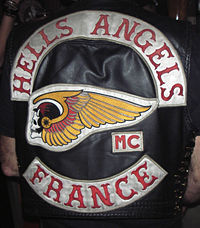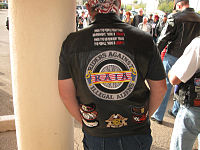- Colors (motorcycling)
-
Three part colors for Hells Angels

Colors are the insignia, or "patches", worn by motorcycle club members on cut-offs to identify membership of their club and territorial location.[1] Club patches have been worn by many different groups but, since the 1960s, have become largely synonymous with Outlaw bikers.[2][3] They are regarded by many to symbolize an elite amongst motorcyclists and the style has been widely copied by other subcultures and commercialized.[4][5]
Colors are considered to represent "significant markers of the socialization" of new members to clubs, rank and present a dominant symbol of identity and marked with related symbolism.[6][7] They can be embroided patches sewn onto clothing or stenciled in paint, the primary symbol being the "back-patch" of club colors. Wearing such clothing is referred to as "flying one's colors".
Colors identify the rank of members within clubs from new members, or "prospects" to full members known as "patch-holders" and usually consist of a top and bottom rocker stating the club name and location and a central logo with the acronym 'MC' standing for "Motorcycle Club". They are used to create social bond and boundaries and, generally, belong to the club's involved rather than the individual wearing them. The wearing of them can often lead individuals to be refused service at related businesses and bars.[8]
Many motorcyclist wearing colors are from "family oriented" motorcycling clubs chartered by the American Motorcyclist Association and wear one-piece patches to differentiate themselves from three piece patches of Outlaw bikers. These generally do not state a territorial location.[8] The motorcycle manufacturer Harley-Davidson notably adopted the style in its branding and community-building effort, the Harley Owners Group.[9]
The term has its roots in military history.[10]
Tattoos
Tattoos may also come under the category of club colors.[11]
References
- ^ Cultural criminology by Jeff Ferrell, Clinton Sanders
- ^ Outlaw Motorcycle Gangs. Journal: Royal Canadian Mounted Police Gazette Volume:49 Issue:5 by D Day. 1987
- ^ Encyclopedia Of Violence: Frequent, Commonplace, Unexpected By Margaret DiCanio
- ^ Harley-Davidson and philosophy: full-throttle Aristotle by Bernard E. Rollin
- ^ Subcultures of Consumption: An ethnography of the New Biker by JW Schouten & JH McAlexander
- ^ The Arts of the Motorcycle: Biology, Culture, and Aesthetics in Technological Choice. Technology and Culture - Volume 41, Number 1, January 2000, pp. 99-115
- ^ Leathers and Rolexs: The Symbolism and Values of the Motorcycle Club by James F. Quinn Deviant Behavior, Volume 30, Issue 3 April 2009 , pages 235 - 265
- ^ a b Over the Edge and Into the Abyss: The Communication of Organizational Identity in an Outlaw Motorcycle Club by Dulaney, William Lee. Florida State University
- ^ Schouten, John W.; McAlexander, James H. (June 1995), "Subcultures of consumption — an ethnography of the new bikers", Journal of Consumer Research (The University of Chicago Press) 22
- ^ The end of internationalism: or world governance? by J. Ørstrøm Møller, 2000
- ^ "Crime Prevention Gang Prevention". State's Attorney's Office. http://www.willcountysao.com/prevention-gang_prevention.htm. Retrieved 2009.
Categories:- Motorcycling subculture
Wikimedia Foundation. 2010.


